
August 20, 2013
The Process of Making Public Art, Demystified
How reconfiguring site helped me think about my sculpture project and art practice
When I saw the e-blast from Arts & Education announcing a two-week residency at School of Visual Arts called Reconfiguring Site, I knew I had to attend. I crossed my fingers and applied to summer school. For some time now I’ve been doing, what like to refer to as ”research and development” on a project that would involve placing a large, colorful aluminum sculpture in a public space. Experimenting with different materials and techniques, I worked to visualize my ideas on a small scale. But I was stuck. When it came to figuring out how to get a commission and funding to actually make the work, I didn’t know what steps to take.
Because I’ve never made a large site-specific sculpture before, I was both excited and apprehensive about my project. What were my concerns? I was worried about making a large artwork that would look outdated or ugly with time. I was concerned with finding materials that would be easy to maintain. I wanted to make something that was cost-effective. And I wanted my sculpture to appeal to the people using the public space, wherever it was placed. Ideally, I wanted it to make people smile, even brighten their day when they encountered the sculpture. Most of all, I worried about how to make a budget and get the artwork made to my demanding specifications within a given time frame. I just didn’t know how to do all this.
Reconfiguring Site promised to address all my concerns, and more. On the first day of class, sculptor Meryl Taradash talked about how to write a successful project proposal. This was followed by visits from a wide array of public and private art organizations whose representatives did a great job of describing their particular practices. We got practical information about everything from the importance of finding a good agency and project manager to work with, writing a timeline and budget, applying for funding, finding a local engineer, learning how to read blue prints, and getting insurance.
The talks were made more valuable by the students’ thoughtful questions, as well as supplemental information provided by the three instructors. International artist and curator Kendal Henry was especially generous in supplying an outpouring of knowledge and information based on his many years of experience making public artwork in New York City and elsewhere. Several days were set aside for those students who wanted to make their own public art on 23rd Street between 5th and 7th avenues with instructor Ed Woodham, artist, curator and director of the slightly subversive not-for-profit organization, Art in Odd Places. This opportunity led to some discussion about “asking forgiveness instead of permission” and the ethical question of whether or not professional artists should ever work for free.
All 14 students decided to participate with performative works based on Ed’s text about numbers. For my artwork, I cleaned a phone shelter, decorated it with numbers and then sat inside it, squeezed onto the shelf below the payphone. I had some meaningful interactions with passersby on a variety of topics like different categories of numbers (prime numbers, rational and irrational numbers, and perfect numbers), the names of skateboarding tricks, how a blind man would experience what I was doing, and why I consider what I do to be art.
During the residency there were other opportunities for philosophical and ethical discussions. The course’s creator, main teacher and coordinator, Anita Glesta was adamant about every artist’s obligation to be politically informed and aware of his or her contribution to society. We had many heated discussions on what “good public art” is, what it creates for the people who experience it, and what sort of legacy it leaves (or fails to leave) behind.
Anita is an out-spoken proponent for an artistic professionalism that includes artists getting paid to do their work. She was always eager to ask the representatives from visiting organizations tough questions about which artists have access to their limited resources, how they are chosen and how much they are remunerated. Her pointed questions exposed limited insider-only access to many institutions and created important transparency for the students.
I came away from my intensive two-weeks of Reconfiguring Site inspired to get to work. The process of making public art was demystified for me, but my concerns about making responsible artwork have not diminished. I am still in the process of redefining my own personal direction and goals. More than anything, I am encouraged by the fact that such a wonderfully honest course exists to guide professional artists in examining how and why they make their work.

Suzanne Russell is an artist, writer, and activist-lawyer who has been living in Copenhagen for the past 23 years. She has a B.A. from Wellesley College in literature and a J.D. from NYU in law. She is a visual artist at heart, but has a wide-ranging art practice that includes providing free legal help to refugees in Denmark. Suzanne has been on the board of the Royal Danish Arts Council and has participated in various “integration” committees and mentoring projects. She is married to a Dane and has two biological children, Alexander and Isabel. She is also guardian and “Danish Mom” to two young men from Afghanistan. Her website is www.suzanne-russell.dk.





